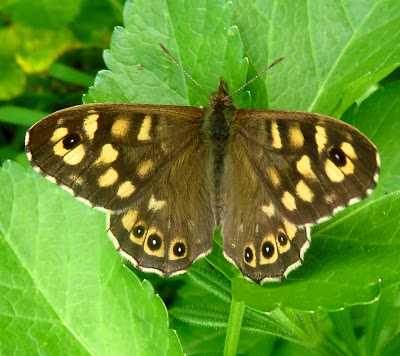Several wheatears were also at the park on Sunday with these two males seen on the seawall. At least ten wheatears were seen, eight of them together with the whinchats in the grazing field.
Several of the wheatears started the day on the beach near the Point, like this male, before heading onto the nearby grazing field. Five wheatears were also in the fields the day before, on Saturday.
Also on Sunday 4 reed warblers were singing along the park dyke and another singing at the pond, ten swallows over the fields, 4 greylag geese, grey heron, 2 little egrets, 2 black-tailed godwits in the fields, 2 summer plumaged bar-tailed godwits on the nearby saltmarsh lagoons, while 3 common terns flew up-river. At the pond a sparrowhawk and 4 pochard.
The first two lapwing broods were seen in the park's grazing fields on Saturday 28th. This parent bird was just settling down in the middle of the field to shelter her four young chicks under her wings. At least one chick from another lapwing brood was seen briefly feeding amongst the tussocks of rushes.
Other birds noted at the park on Saturday included 15 swallows, 2 house martins, yellow wagtail, 3 Mediterranean gulls, whimbrel, pair of avocet, grey heron, 2 little egrets, 5 pochard, 2 common tern and 4 greylag geese.
Near the Oyster Fishery on Saturday Martin Cock saw 4 common terns, 24 brent geese and heard the nightingale while at West Mersea the great northern diver was offshore. At Rewsalls marsh, Andy Field reported two singing sedge warblers that have joined last week's bird, also a whimbrel and 3 wheatears.
One of four whitethroats singing at the park on Sunday was this one photographed by Andy. A willow warbler was also heard singing at the park.
On Friday 27th a pair of grey partridge was seen flying onto the main part of the park, 15 linnets feeding on the park, whimbrel flew over calling and a little owl perched up by the car park at dusk. Twenty linnets fed in the field beside Manwood Grove.
A willow warbler and whitethroat were heard singing at the park on Thursday 26th and the pair of grey partridge flew across the main field of the park.
On Wednesday lesser whitethroat, whitethroat, 2 swallows, house martin, 20 tufted duck and 4 pochard were noted at the park.
Three swifts and a swallow flew rapidly west over the car park on Tuesday 24th. The first cuckoo at the park was a bird seen calling from wires to the north, by Andy Field who also noted 2 wheatears and 2 reed warblers.
A nightingale was heard singing on Tuesday in the same plantation near the Oyster Fishery, where one was singing last year. Two cuckoos and a Cetti's warbler were heard singing by Martin Cock who also had the rare sight of a pair of bullfinches perch briefly before flying towards Shop Lane. Seven pochard were seen on the nearby pond near the Oyster Fishery.
A male hen harrier was reported by Neil Mortimer flying over Rewsalls fields towards Meeting Lane on Tuesday.
This first spring speckled wood butterfly at the park was seen on Wednesday 25th.
One of the ever elusive adders was glimpsed at the park on Thursday 26th.





















































